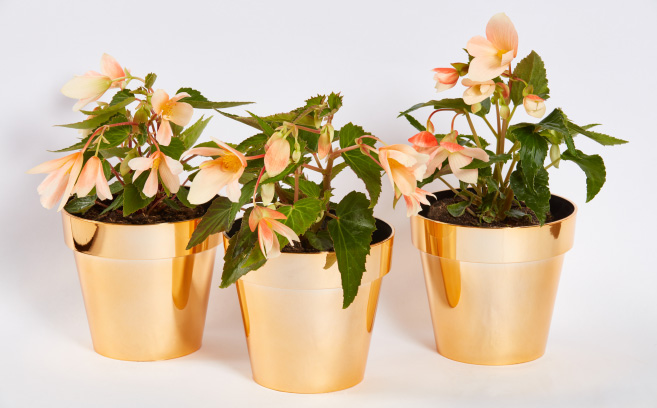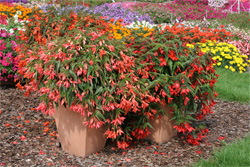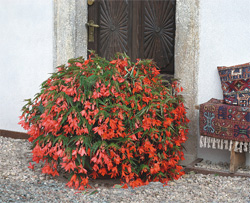E144 Copacabana
F1 Tricolour
A colour which is unique
even on a global scale, a combination of
apricot, cream and yellow shades. These plants
are already more compact than other varieties
in this series during the planting stage.
The young plants grow to a height of 13–15
cm, the flowers have a wealth of branches
and grow exuberantly.
The final height is 30–35 cm. Exuberant bloom and creation of an effective overhang
of medium length are the natural characteristics of this variety.
 CULTIVATION RECOMMENDATIONS
CULTIVATION RECOMMENDATIONS
Sowing time: January for flowering bedding plants from May onwards.
Growing Begonia boliviensis is generally quite similar to cultivation
of Begonia tuberhybrida.
 Germination – Stage 0
Germination – Stage 0
Media pH 5.5 – 5.8, good quality sowing media with 0.5kg PG-Mix
(14-16-18) per m3. Begonia are sensitive to damping-off disease
of seedlings therefore we recommend application of Trichoderma
fungi and Previcur (propamocarb) pesticide as a precaution. Sciarid
larvae (Bradysia paupera, Bradysia aprica) present in the medium
will dramatically decrease the number of sprouted seedlings. In
this case we recommend precautionary application of parasitic nematodes
Steinernema feltiae.
Germination- Stage 1
High humidity close to 100% and temperature 21-23 °C are the basic
conditions leading to good results. Do not cover the pellets.
The length of this stage lasts 7-10 days until radicle emergence.
Visual Note: At the end of Stage 1, the radicle grows from the
destructed pellet and the roots start to form.
Moisture: Moisture level 5 (saturated)
Humidity: 100%, even short drops of humidity can harm the germinating
seeds, to maintain high humidity you can cover the plug with plastic
foil.
Media EC 0.5-0.75
Lighting: Light is necessary for germination. The light intensity
in the chamber needs to be 200-1,000 lux (20-100 foot candles).
 Germination-Stage 2
Germination-Stage 2
In this stage it is necessary to ensure optimum conditions for
growth of the root system. This especially means high humidity.
Visual Note: The seeds are completely sprouted by the end of stage
2. The radicle is developed, the stem is present and cotyledons
have expanded.
Moisture: The moisture alternates between levels 4 (wet) and 3
(moist). Oversaturated media will inhibit the growth of the root
system deep into the media due to a shortage of oxygen. Seedlings
are tiny and therefore watering must be gentle so the first roots
that fixate the plant in the media do not tear out.
Humidity: constantly keep the humidity around 95%
Media Temperature: 21-23 °C
Media EC: 0.5-1.0, in this stage, begonia are sensitive to high
EC
Lighting: Begin with supplemental lighting after germination. Begonia
boliviensis is an obligate long-day plant. During a short day,
the seedlings stagnate and form miniature tubers. Extend the day
length up to 14-16 hours using supplemental photosynthetically
active light. High quality plants are produced at an intensity
of 4,500-7,000 lux (450-700 foot candles).
Germination Stage 3
Optimum water and nutrient management in this stage will result
in a perfect root system that will allow for optimum development
of the above-ground part.
Visual Note: At the end of Stage 3, the roots should be penetrating
the plug cell and the first true leaves will have developed.
Moisture: The moisture alternates between levels 4 (wet) and 2
(medium). The alternation of these moisture levels will ensure
a sufficient amount of oxygen in the whole plug and the roots can
grow through the media right to the bottom.
Media Temperature: 18-20 °C
Fertilizer: if necessary 2 times per week or more often; 50 ppm
nitrogen (19+6+20)
Media EC: 1.0 – 1.5
Lighting: same as Germination Stage 2
Germination Stage 4
In this stage, it is important to take care of the plants' health
and to apply fungicides if necessary. Dense growth could, in unsuitable
growing conditions, suffer from Botrytis cinerea.
Visual Note: At the end of Stage 4, the roots should hold the plug
mass together easily. The shoots should have 2-3 true leaves.
Moisture: The moisture alternates between levels 4 (wet) and 2
(medium). Sufficient watering must be ensured so the whole plug
is moist. Too frequent but insufficient watering is not appropriate.
Fertilizer: if necessary 2 times per week or more often; 100 ppm
nitrogen (19+6+20)
Media EC: 1.0 – 1.5
Lighting: same as in Germination Stage 2. In the event of light
intensity close to 25,000 lux (2,500 foot candles) the plants should
be shaded.
Temperatures below 14 °C result in stagnation of growth and formation
of tubers.
Growth Regulators: Generally not needed. If necessary, it is possible
to use Cycocel (chlormequat chloride) treatment at 30-50 ppm (active
substance). At most two treatments.
Further growing
Temperature: After transplanting, temperature 18-20 °C during the
night. Lower the temperature to 16-18 °C later.
Moisture: Alternate between moisture levels 4 (wet) and 2 (medium).
Humidity: 40-70%. Using of horizontal airflow is beneficial for
the health of the plants.
Fertilizer: if necessary 2 times per weeks or more often; 100-150
ppm nitrogen (19+6+20) alternate (12+12+36). Increased N: K ratio
towards K has a positive influence on the health of the plants
and their compactness. Fertilizer usage with high ammonium nitrate
content might result in root damage especially at lower temperatures.
Growth Regulators: Generally not needed. If necessary, it is possible
to use Cycocel (chlormequat chloride) treatment at 30-50 ppm (active
substance). At most two treatments.
These suggestions are only guidelines and may have to be modified
to meet the individual grower's needs.
Moisture level 5 (saturated): Water is easily observed in the media.
Moisture level 4 (wet): Media is wet to touch, but not saturated.
Moisture level 3 (moist): Media is black but not glistening.
Moisture level 2 (medium): Media has changed colour from black
to a medium brown.

